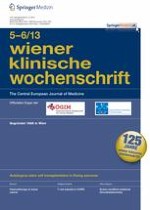01.03.2013 | original article
Detection of Plasmodium sp.-infested Anopheles hyrcanus (Pallas 1771) (Diptera: Culicidae) in Austria, 2012
Erschienen in: Wiener klinische Wochenschrift | Ausgabe 5-6/2013
Einloggen, um Zugang zu erhaltenSummary
On July 15, 2012, adult Anopheles hyrcanus (Pallas 1771) mosquitoes were caught next to a farm barn near Rust, Burgenland, close to Lake Neusiedl National Park in eastern Austria. Six weeks later, adults of this invasive species were also found in a sheep shelter outside the village of Oggau and another 2 weeks later, in a horse barn in Mörbisch. The morphological typing was confirmed genetically by amplification and sequencing of a 1,404-bp-long fragment within the 5.8S ribosomal RNA gene, the internal transcribed spacer 2, and the 28S ribosomal RNA gene. Out of two A. hyrcanus pools analyzed, one was found positive for Plasmodium sp. A 460-bp-long sequence within the mitochondrial cytochrome b region revealed 100 % identity to a sequence of a Plasmodium parasite identified in a New Zealand bellbird (Anthornis melanura). The Austrian finding sites are close to the Hungarian border. In Hungary, the occurrence of A.
hyrcanus was already reported in 1963. A. hyrcanus is considered the most important potential vector of malaria in southern France today. In Austria, sporadic autochthonous malaria cases could emerge, caused by immigration from malaria-endemic countries and heavy tourism. However, the broad population coverage of the Austrian health care system makes the reestablishment of endemic areas for malaria unlikely.
Anzeige
